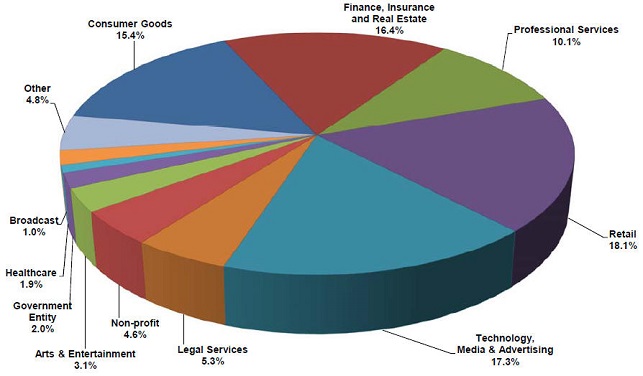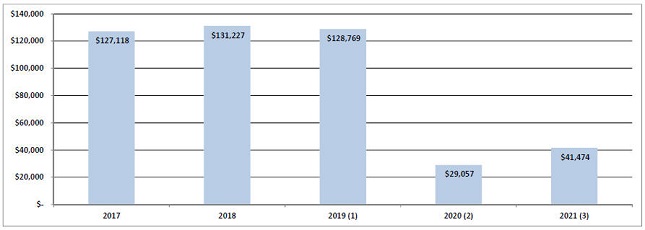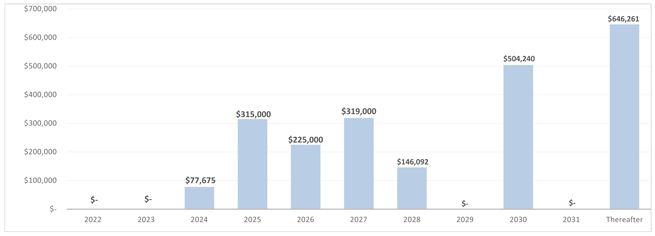| | |
 | | First Quarter 2022 Supplemental Definitions |
Funds From Operations (“FFO”)
We compute FFO in accordance with the “White Paper” on FFO published by the National Association of Real Estate Investment Trusts, or NAREIT, which defines FFO as net income (loss) (determined in accordance with GAAP), excluding impairment writedowns of investments in depreciable real estate and investments in in-substance real estate investments, gains or losses from debt restructurings and sales of depreciable operating properties, plus real estate-related depreciation and amortization (excluding amortization of deferred financing costs), less distributions to non-controlling interests and gains/losses from discontinued operations and after adjustments for unconsolidated partnerships and joint ventures. FFO is a widely recognized non-GAAP financial measure for REITs that we believe, when considered with financial statements determined in accordance with GAAP, is useful to investors in understanding financial performance and providing a relevant basis for comparison among REITs. In addition, we believe FFO is useful to investors as it captures features particular to real estate performance by recognizing that real estate has generally appreciated over time or maintains residual value to a much greater extent than do other depreciable assets. Investors should review FFO, along with GAAP net income, when trying to understand an equity REIT’s operating performance. We present FFO because we consider it an important supplemental measure of our operating performance and believe that it is frequently used by securities analysts, investors and other interested parties in the evaluation of REITs. However, because FFO excludes depreciation and amortization and captures neither the changes in the value of our properties that result from use or market conditions nor the level of capital expenditures and leasing commissions necessary to maintain the operating performance of our properties, all of which have real economic effect and could materially impact our results of operations, the utility of FFO as a measure of its performance is limited. There can be no assurance that FFO presented by us is comparable to similarly titled measures of other REITs. FFO does not represent cash generated from operating activities and should not be considered as an alternative to net income (loss) determined in accordance with GAAP or to cash flow from operating activities determined in accordance with GAAP. FFO is not indicative of cash available to fund ongoing cash needs, including the ability to make cash distributions. Although FFO is a measure used for comparability in assessing the performance of REITs, as the NAREIT White Paper only provides guidelines for computing FFO, the computation of FFO may vary from one company to another.
Modified Funds From Operations (“Modified FFO”)
Modified FFO adds back an adjustment for any above or below-market ground lease amortization to traditionally defined FFO. We believe this a useful supplemental measure in evaluating our operating performance due to the non-cash accounting treatment under GAAP, which stems from the third quarter 2014 acquisition of two option properties following our formation transactions as they carry significantly below market ground leases, the amortization of which is material to our overall results. We present Modified FFO because we believe it is an important supplemental measure of our operating performance in that it adds back the non-cash amortization of below-market ground leases. There can be no assurance that Modified FFO presented by us is comparable to similarly titled measures of other REITs. Modified FFO does not represent cash generated from operating activities and should not be considered as an alternative to net income (loss) determined in accordance with GAAP or to cash flow from operating activities determined in accordance with GAAP. Modified FFO is not indicative of cash available to fund ongoing cash needs, including the ability to make cash distributions.
Core Funds From Operations (“Core FFO”)
Core FFO adds back to Modified FFO the following items: loss on early extinguishment of debt, acquisition expenses, severance expenses and IPO litigation expense. The Company believes Core FFO is an important supplemental measure of its operating performance because it excludes non-recurring items. There can be no assurance that Core FFO presented by the Company is comparable to similarly titled measures of other REITs. Core FFO does not represent cash generated from operating activities and should not be considered as an alternative to net income (loss) determined in accordance with GAAP or to cash flow from operating activities determined in accordance with GAAP. Core FFO is not indicative of cash available to fund ongoing cash needs, including the ability to make cash distributions. In future periods, we may also exclude other items from Core FFO that we believe may help investors compare our results.
Core Funds Available for Distribution (“Core FAD”)
In addition to Core FFO, we present Core FAD by (i) adding to Core FFO non-real estate depreciation and amortization, the amortization of deferred financing costs, amortization of debt discounts and non-cash compensation expenses and (ii) deducting straight line rent, recurring second generation leasing commissions, tenant improvements, prebuilts, capital expenditures, furniture, fixtures & equipment, amortization of debt premiums and above/below market rent revenue. Core FAD is presented solely as a supplemental disclosure that we believe provides useful information regarding our ability to fund our dividends. Core FAD does not represent cash generated from operating activities and should not be considered as an alternative to net income (loss) determined in accordance with GAAP or to cash flow from operating activities determined in accordance with GAAP. Core FAD is not indicative of cash available to fund ongoing cash needs., including the ability to make cash distributions. There can be no assurance that Core FAD presented by us is comparable to similarly titled measures of other REITs.
Net Operating Income (“NOI”)
NOI is a non-GAAP financial measure of performance. NOI is used by our management to evaluate and compare the performance of our properties and to determine trends in earnings and to compute the fair value of our properties as it is not affected by; (i) the cost of funds of the property owner, (ii) the impact of depreciation and amortization expenses as well as gains or losses from the sale of operating real estate assets that are included in net income computed in accordance with GAAP, (iii) acquisition expenses, impairment charges, loss on early extinguishment of debt and loss from derivative financial instruments or (iv) general and administrative expenses and other gains and losses that are specific to the property owner. The cost of funds is eliminated from net operating income because it is specific to the particular financing capabilities and constraints of the owner. The cost of funds is also eliminated because it is dependent on historical interest rates and other costs of capital as well as past decisions made by us regarding the appropriate mix of capital which may have changed or may change in the future. Depreciation and amortization expenses as well as gains or losses from the sale of operating real estate assets are eliminated because they may not accurately represent the actual change in value in our office or retail properties that result from use of the properties or changes in market conditions. While certain aspects of real property do decline in value over time in a manner that is reasonably captured by depreciation and amortization, the value of the properties as a whole have historically increased or decreased as a result of changes in overall economic conditions instead of from actual use of the property or the passage of time. Gains and losses from the sale of real property vary from property to property and are affected by market conditions at the time of sale which will usually change from period to period. These gains and losses can create distortions when comparing one period to another or when comparing our operating results to the operating results of other real estate companies that have not made similarly timed, purchases or sales. We believe that eliminating these costs from net income is useful to investors because the resulting measure captures the actual revenue, generated and actual expenses incurred in operating our properties as well as trends in occupancy rates, rental rates and operating costs. However, the usefulness of NOI is limited because it excludes general and administrative costs, interest expense, depreciation and amortization expense and gains or losses from the sale of properties, and other gains and losses as stipulated by GAAP, the level of capital expenditures and leasing costs necessary to maintain the operating performance of our properties, all of which are significant economic costs. NOI may fail to capture significant trends in these components of net income which further limits its usefulness. NOI is a measure of the operating performance of our properties but does not measure our performance as a whole. NOI is therefore not a substitute for net income as computed in accordance with GAAP. This measure should be analyzed in conjunction with net income computed in accordance with GAAP. Other companies may use different methods for calculating NOI or similarly titled measures and, accordingly, our NOI may not be comparable to similarly titled measures reported by other companies that do not define the measure exactly as we do.
Same Store Net Operating Income (“SSNOI”)
In addition to NOI, we present Same Store NOI. Our Same Store portfolio includes all of our properties owned and included in our portfolio for all periods presented. It does not include properties held-for-sale or those properties which we otherwise expect to dispose of in the subsequent quarter.
EBITDA and Adjusted EBITDA
We compute EBITDA as net income plus interest expense, income taxes and depreciation. We present EBITDA because we believe that EBITDA, along with cash flow from operating activities, investing activities and financing activities, provides investors with an additional indicator of its ability to incur and service debt. EBITDA should not be considered as an alternative to net income (determined in accordance with GAAP), as an indication of our financial performance, as an alternative to net cash flows from operating activities (determined in accordance with GAAP), or as a measure of its liquidity. For adjusted EBITDA, we add back impairment charges.
Page 23




